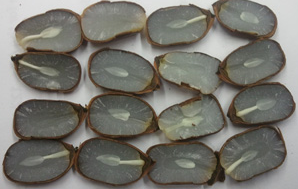Divine Fruit?
If you were offered fruit with the nickname “divine fruit” or “fruit of the gods,” would you try it? It sounds delicious, right? The scientific genus name of one of our native Indiana trees, Diospyros virginiana, is loosely translated into those descriptions.
Its more recognizable name is American persimmon or common persimmon. A Purdue Extension forester said that if you have tasted a ripe persimmon on a crisp fall day, you might agree with the moniker implied in its scientific name.
Lenny Farlee, Purdue Extension forester, said that several persimmon tree species are found in both the New and Old World, and have been used for food and wood products for centuries.
“Our American persimmon is native to the southern half of Indiana but can survive in the northern half of the state as well,” he said. “The ripe fruit is famous for the sweet orange pulp used in puddings, cookies, and candies.”
However, the keyword is “ripe.” Farlee said that if you are unlucky enough to eat a persimmon that has not yet ripened, your opinion of its eating quality will be quite different. “Unripe persimmons have a high tannin content that makes the fruit very astringent – I describe it as feeling like your head is shrinking while simultaneously trying to expel a glue ball from your mouth!” he said.
Knowing this, I once wanted to experience this mouth-twisting experience for myself, just to say that I had experienced it. I think Farlee’s description pretty well hits the mark. In fact, Captain John Smith of the pilgrims said of persimmons, “If it be not ripe, it will draw a man’s mouth awry with much torment.”
“Most dedicated persimmon collectors wait for the fruit to become soft and fall from the tree before collecting to avoid this unpleasant experience,” said Farlee. “Contrary to popular belief, the fruit does not have to experience a frost to ripen.” Many varieties, including some of the best, lose their “pucker-power” as they become ripe long before frost has a chance to do its work. Nevertheless, some people still wait until after a good frost to harvest. Farlee said that persimmon fruit normally ripens in September and October, but some trees hold fruit well into winter.
Birds and wildlife relish the fruit of the persimmon as well.
In addition to its use for food, Farlee said that the persimmon has some folk traditions related to winter weather forecasting. “It was thought the shape of the embryo in the seed could predict the winter weather: a spoon shape indicated deep snow, a knife would indicate icy cutting winds and a fork meant it would be mild with plenty to eat until spring,” he said. He collected a few seeds from trees here on the Purdue University campus in 2018 and cut them open. What do you think they look like?
 Embryos in persimmon seeds – are they mostly a spoon, a knife, or a fork? Photo: Lenny Farlee, Purdue Extension Forester
Embryos in persimmon seeds – are they mostly a spoon, a knife, or a fork? Photo: Lenny Farlee, Purdue Extension Forester
If you would like to grow persimmon trees, keep in mind that they are dioecious trees. “Male and female flowers are normally formed on separate trees, so plant several to get good pollination,” Farlee said. Only the female trees bear fruit. Trees are self-pollinating only in rare instances. Among possible sources, the Indiana DNR Division of Forestry Nursery sells American persimmon seedlings. It may be many years before seedlings can be identified as male or female.
To read Farlee’s original article, go to: https://www.purdue.edu/fnr/extension/the-fruit-of-the-gods-from-an-indiana-tree/. For ideas on how to use persimmons, go to: https://extension.purdue.edu/foodlink/food.php?food=persimmon.
 Rebekah D. Wallace, University of Georgia, Bugwood.org
Rebekah D. Wallace, University of Georgia, Bugwood.org